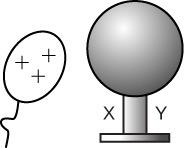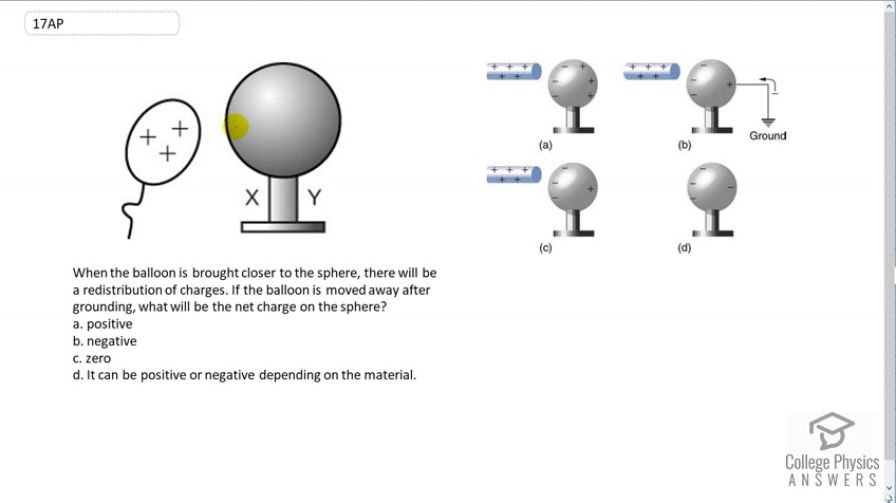Question
When the balloon is brought closer to the sphere, there will be a redistribution of charges. If the balloon is moved away after grounding, what will be the net charge on the sphere?
- positive
- negative
- zero
- It can be positive or negative depending on the material.

Final Answer
(b)
Solution video
OpenStax College Physics for AP® Courses, Chapter 18, Problem 17 (Test Prep for AP® Courses)

vote with a rating of
votes with an average rating of
.
Video Transcript
This is College Physic Answers with Shaun Dychko. In this question we have an initially neutral metal sphere and a positively charged balloon is brought close to it. So the sphere will become polarized with negative charges being attracted to the side of the sphere closest to the positively charged balloon and the other side will end up being positively charged because it has lost some electrons that have gone over to this side. So far, this sphere has a net charge of zero. But we're told that the sphere is then grounded and let's suppose that we attach a wire to ground on the positive side. That'll be similar to this figure from the textbook. That will cause electrons to go from the ground up through this wire and neutralize the positive charges on this side of the metal sphere. So this metal sphere on this side will become neutral. Now the sphere will still be polarized because this balloon is here. So this side will still be negative and so we'll still have negative charges there, but this side will be neutral. Now if this ground wire is then broken -- and so we have a break in the wire, it's gone let's say -- then the balloon is taken away, we will be left with a picture like this with the sphere will have all of the charges evenly distributed throughout the sphere, all these negative electrons. So this sphere will end up being negatively charged and so the answer is B. But compare what would happen after the balloon is taken away with this grounding wire business and without the grounding wire. So if the grounding wire had not been used, there would have been a positive charge on the far side of this sphere, enough of them to correspond to each electron that's on the near side of the sphere. Then after the balloon was taken these negative charges would move over and neutralize each of the positive charges so that the net charge would have been zero. But now because of this grounding wire that was put here, some electrons came up to neutralize each of these positive charges and so after the balloon is taken away, you know, but the ground wire is destroyed first by the way, and so then the positives were neutralized by electrons from the ground. Then when the balloon is taken away, there are no positive charges on the other side to neutralize each of these negative charges anymore. So there is an net negative charge. Okay.